Competency Management System
The ready-to-use system of truth
Discover the best way to manage your organization’s competencies and skills with TalentGuard’s world-class platform. Gain the ability to create or extend your competency frameworks, customize job profiles, assign learning and development options, govern workflow and collaborate with other talent management applications.
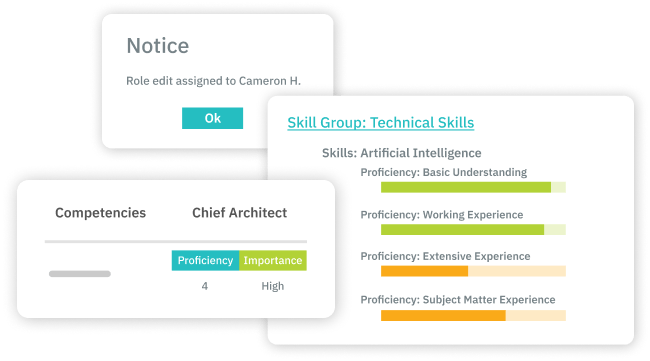
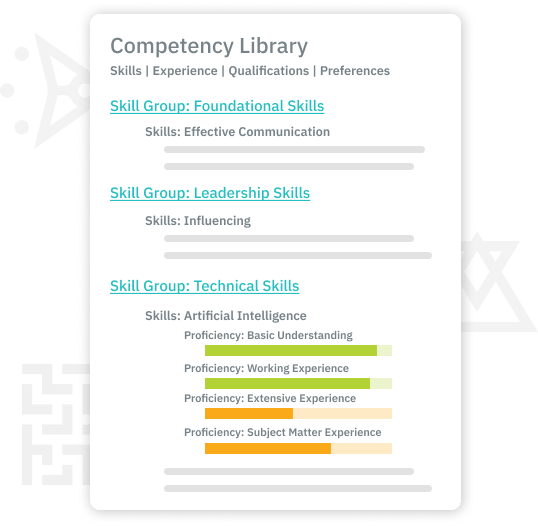
Create
Ability to create, edit and compare multiple competencies, including: Skills, Experiences, Qualifications and Preferences that are required for job functions.
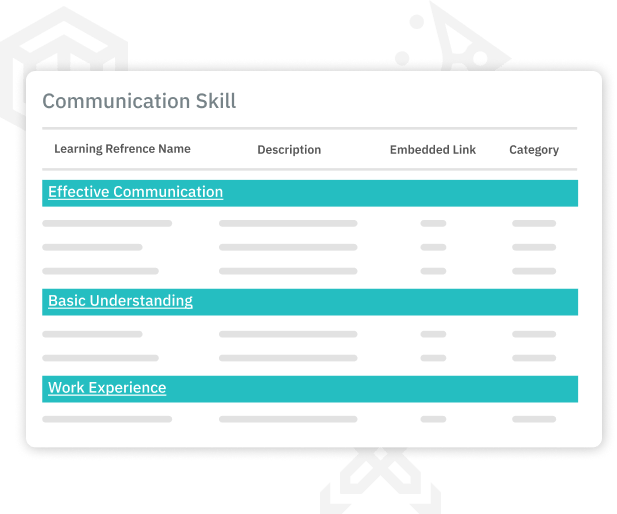
Map
Ability to map competencies, job grades, learning resources and other data to job profiles.
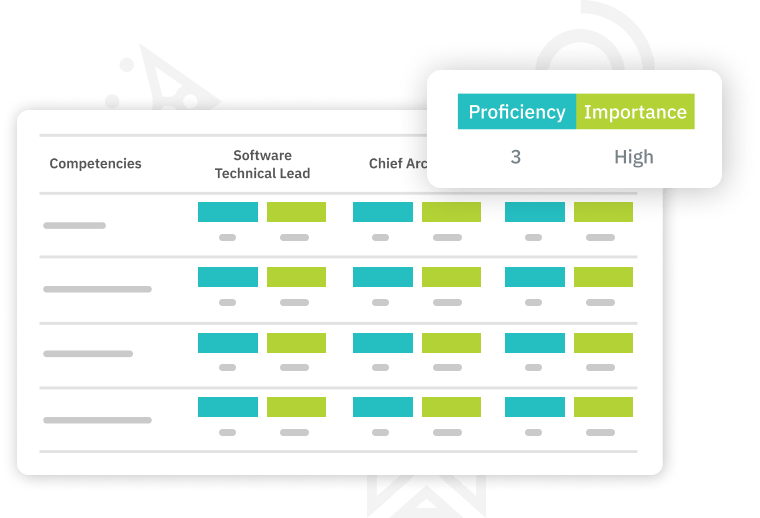
Calibrate
Job Profile calibration includes adjusting the level of proficiency and importance level of associated competencies across job profiles and grade levels.
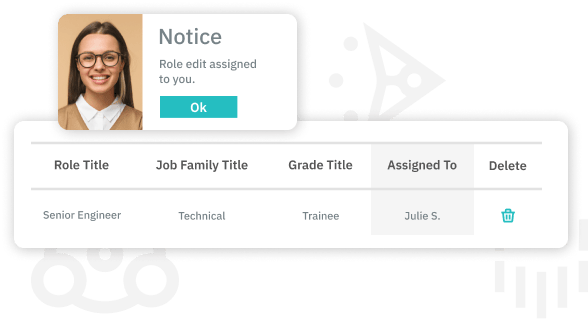
Govern
Manage entitlement, rules, roles and policies to seamlessly govern job role data.
Get Your Free Demo & See our Platform in Action
Select from one of the bundles below and we will tailored the demo to your needs. Let us show you how TalentGuard’s solutions adapt to your industry.
Automate
Create skill profiles, create detailed job descriptions, align learning content with specific skills, and chart clear career path progressions to set the foundation for effective talent management.
Automate includes:
- Create Skill and Competency Profiles
- Develop Job Descriptions
- Map Learning to Skills and Competencies
- Map Career Path Progressions
Assess
Effectively assess their employees’ skills, identify gaps, and implement strategies to develop a skilled and competent workforce prepared to meet current and future challenges.
All the Automate features plus the ability to:
- Create a Skills Inventory
- Conduct Gap Analysis
Engage
Organizations can significantly enhance their talent development strategy and workforce effectiveness by assessing employee skills, curating personalized learning paths, recommending appropriate career paths, and tracking career goals.
All the Automate features plus the ability to:
- Assess Employee Skills and Competencies
- Curate Personalized Employee Learning Paths
- Recommend Employee Career Paths
- Track Career Goals
Optimize
Building talent pools, measuring employee performance, tracking certifications, and conducting multi-rater feedback enhance talent management, ensure compliance, and foster organizational leadership development.
All the Engage features plus the ability to:
- Build Talent Pools
- Measure Employee Performance
- Track Employee Certifications
- Conduct Multi-Rater Leadership Feedback
Trusted by:




Your workforce is changing. Never be unprepared again.
Read our eBook
Additional information
Competency management systems offer excellent benefits for better workforce management. These software solutions give you one place to access all of the data in your talent pipeline. This makes the tasks of career pathing, succession planning and assigning employees for upcoming projects far more intuitive for both your management and HR team.
You may be wondering about what qualities to look for in the best skills management software. It’s a broad topic and a competency management system, meaning the software your company uses to identify and categorize employee skills, can take a while to research. For your HR team, finding the right solution can be time-consuming, but partnering with the best competency management system for your organization will save your company a great deal of time and resources in the long term.
Today we will be discussing what a competency management model is. We’ll dive into factors that help determine the best competency management models and talk about the importance of learning management systems (LMS) in your company’s solution.
What does LMS mean and where is the best place to start?
Typically, your LMS integration gives you a single platform to offer courses to staff, track certifications and performance, and reporting options. The learning management aspect of your competency management system gives your existing staff wonderful benefits in their own career trajectories. They have access to new training initiatives to prepare for positions they want in their future. They can also update their skills in areas that may be evolving and have access to the latest training necessary for regulatory requirements, such as harassment training and other initiatives that are important to maintain.
A learning management system should be well integrated into a good competency management model. This allows your team a 360 view of current talent and the resources you need to help your employees learn new skills. Systems should be user-friendly to save staff time during training. They should also offer tools to help employees stay up to date with any ongoing training requirements.
Competency Management Framework
There are different types of competency framework, and you should customize the competencies that are important for your business goals and objectives. Your competency management process should include skills, experience, and preferences to gather a full picture of what makes up your workforce.
You may have a number of employees who share a certain skill. For instance, 100 employees who have a high proficiency with a software needed for an open position. However, once you factor in the number of employees who are highly interested in a career trajectory that aligns with the open position, that choice might narrow down to only 20 employees. Taking those 20 employees, you can assess how many of them have all of the other proficiencies and experiences necessary for that position. In this example, say you only have 5 employees who have all of the skills at the desired proficiency levels and the experience necessary to competently manage the open position on day one.
You can see once you eliminate employees who don’t have all of the skills related to the position or project, there is a much more manageable selection to assess. With the 5 employees left, you might interview each to gauge interest and use other determinations, such as the amount of time they’ve been with the company, to determine the final selection.
You can see from the above example that your competency framework model can make a big difference in the amount of time it takes to assess which current employees might be right for a new opening or project. Building a competency framework template that aligns with your current and future objectives can make career pathing, succession planning and talent selection far more productive and efficient.
Competency Management Software
The best competency management system will offer functionality that allows you to share data across all of your talent management initiatives. This allows you to save a lot of time and frustration as doing this process manually requires a great deal of effort. Your HR team would need to dip into multiple internal and external skills data sets to be successful without a cohesive software.
By putting all of the functionality together in one competency management software, your team can easily develop reporting options for a full company view, dig deeper into the composite of a team, or go further to help individual employees thrive and excel.
The solution should be user-friendly to support competency management training for your staff. Competency assessment software serves the company in time efficiency and resource management, but it’s also a benefit to your employees. They can use the learning solutions to help them master new skills. The features can also help individual employees see which skills they need to develop for the future career trajectory they want to achieve.
Competency management software gives you one platform, with an intuitive dashboard, to manage all of the skill sets within your company. You can easily see gaps in skills to develop internal education initiatives and it makes scheduling and assigning new projects far more intuitive.
The Importance of Competency Management
There are many benefits of utilizing a competency management solution. Having a good employee skills management software gives your company options for reporting and assessing the staff you currently have. These data sets can be accessed easily and used to assign current and future roles.
It’s difficult to determine all of the skills that any one employee has without some sort of skills database. When you multiply that by the number of employees in your organization, you can see how integral keeping a current data set is. You can’t accurately assign the right personnel to the right tasks if you don’t know what their abilities are. Without the background knowledge of their proficiencies in certain areas, it can be a guessing game whether you’re assigning the right people.
Often, you’ll have excellent staff members who have a wide variety of skills and talents. They may not be as vocal with managers about their experience. This could mean a missed opportunity to put the right person in the best job for them and this is something your company should prioritize. When your employees find success in their positions, they feel appreciated, are more engaged and enjoy their time with your company more.
For your management, having access to this wealth of information makes choosing who to promote and cross-train far easier. They can research performance reviews and easily see proficiency levels.
A good competency management system can be customized to align with your unique business goals. You can update frameworks to include hard and soft skills, keep up to date with regulatory requirements, and offer more opportunities for growth to your existing staff.
